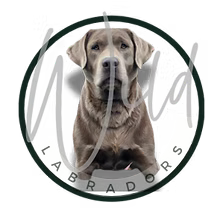Do I Use a Harness for My English Labrador?

I’ve been around dogs my entire life. Not casually; I mean engulfed, consumed, surrounded by litters, leads, and Labs 24/7. And if there’s one thing that makes my eye twitch more than barking or drool on fresh floors, it’s this:
A 90-pound dog in a harness dragging their owner across the driveway like it’s the Iditarod.
I see it everywhere. And I get it, people mean well. But let’s break this down before the “Harnesses are more humane!” crowd comes for me.
Let’s talk about the gear. If you’ve got a blocky-headed English Labrador that walks like a linebacker chasing a cheeseburger, you’ve probably wondered:
- “Should I use a harness?”
- “Are collars cruel now?”
- “What if I ruin their neck forever?”
Let’s unpack the drama and get real, because not every tool is evil, and not every trend is truth.
Here’s the Truth:
Do I use a harness?
No, not really.
They’re sometimes useful. But they’re not the magical answer TikTok makes them out to be.
My Beef with Harnesses (Especially on Big Dogs)
- They enable pulling. Most are back-clip. That means you’re giving your dog more leverage to launch into orbit.
- They teach nothing. You’re not fixing pulling, you’re just surviving it.
- They rub weird. Especially on English Labradors with deep chests and wide shoulders. Fit is awkward, even if it looks “cute.”
- They create mental detachment. Collars build focus. Harnesses (on the wrong dog) build chaos.
- They make owners lazy. Sorry. But if your whole walking strategy is “just clip and hope,” you’re not actually communicating with your dog.
The Myth Buster Moment
Collar Myths (and the Truth)
- “Collars damage the trachea!”
Truth: Any collar can harm the trachea—if your dog is pulling nonstop and you’re yanking like you’re flying a kite. But so can a harness that compresses the shoulders or spine.
— Proper training > panicking about necks. - “Harnesses are safer and more humane.”
Truth: Depends on how you use them. A back-clip harness can enable pulling and actually give your dog more momentum to drag you down the street.
— More humane isn’t “whatever’s trendy”—it’s what gives your dog structure, safety, and guidance. - “Collars make dogs anxious.”
Truth: Dogs don’t get anxious from gear—they get anxious from confusion and lack of boundaries. A well-fitted collar attached to a confident human? That’s security.
— It’s not the collar—it’s how it’s used. - “Pressure on the neck is always harmful.”
Truth: Your dog’s neck is not made of glass. Dogs correct each other by nudging the neck. A quick leash cue isn’t the same as constant pressure. You’re not choking your dog unless you’re misusing the leash.
When I Do Recommend a Harness (Temporarily):
- Brand new puppy with no leash foundation
- Post-op or senior dog needing support
- Confidence-building in totally new environments
- As part of a training plan, not a crutch
“We never relied on gadgets to control a Labrador—just a flat collar, a calm presence, and a short lead. It’s not about force. It’s about focus.”
— Inspired by the Martengail approach
A Legacy Approach: Martengail and the Power of a Short Lead
If you’ve been in the English Labrador world long enough, you’ve heard of Martengail, a respected, long-standing kennel known for producing structurally sound, even-tempered Labs for both show and home.
And guess what their handlers preferred?
Short lead work.
Not harnesses. Not retractables. Not gear with gimmicks. Just a flat collar, a standard 6-foot leash, and timing, consistency, and calm pressure-release training.
They believed in using the leash as a communication tool, not a physical restraint. Their approach was clear: dogs should walk beside you because they understand what’s expected, not because you’ve geared them up like they’re headed into battle.
And it worked. Their English Labradors were known for composure, clarity, and connection; not chaos on the sidewalk.
What I Actually Use:
A well-fitted flat collar. With praise, food, timing, and the kind of patience that comes from raising literal hundreds of dogs.
Because at the end of the day, the collar isn’t the problem.
The leash isn’t the problem.
The lack of communication is the problem.
Why That Matters for You
Whether you’re raising a pet or showing in the ring, English Labradors need calm structure – not hardware. If the big-name breeders like Martengail focused on leash manners instead of tool hacks, there’s something to that. It’s not about force, it’s about focus.
Monica’s Mini Rant Recap:
- Harnesses aren’t evil – but they’re way overused
- English Labs = thick bodies, strong necks, need structure, not shortcuts
- If your dog is dragging you, stop switching gear and start teaching pressure
- Tools are fine. But training wins every time
I will die on this hill. Respectfully.









Responses